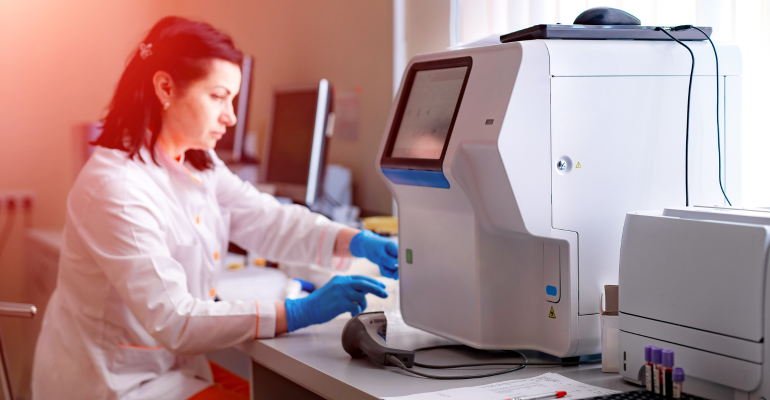Haematology has recently witnessed remarkable advancements in laboratory techniques and technologies to assess blood coagulation and fibrinolysis. This has improved processes and is making an impact on the diagnosis, monitoring, and treatment of various haematological disorders.Automated coagulation analysers, for instance, have improved testing efficiency and accuracy, allowing a comprehensive assessment of coagulation profiles.
The direct measurement of fibrinolytic components provided valuable insights into fibrinolytic activity and related disorders, while molecular genetic techniques, such as PCR and DNA sequencing, enabled the precise detection of genetic mutations associated with coagulation disorders. Advanced imaging techniques, including electron microscopy and confocal microscopy, have further shed light on clot formation and dissolution at the molecular level. “In the past years, blood coagulation and fibrinolysis monitoring has become crucial to diagnose causes of bleeding, assess bleeding risk, develop anticoagulant therapy, and measure the efficacy of the treatment,” explained Prof. Phandee Watanaboonyongcharoen, Associate Professor and Medical Director at the Department of Laboratory Medicine, Chulalongkorn University in Thailand.
Related: Improving Efficiency in the Haematology Laboratory
“Point-of-care testing for coagulation monitoring plays an important role in blood coagulation detection and treatment.”
Latest developments in flow cytometry
Recent advancements in flow cytometry is revolutionising the field of haematology. The introduction of high-dimensional flow cytometry has led to the simultaneous analysis of multiple parameters, enabling a more comprehensive understanding of haematological disorders. Additionally, the utilisation of mass cytometry, or CyTOF, has expanded the repertoire of markers that can be measured, offering increased sensitivity and specificity. Furthermore, the integration of single cell genomics and transcriptomics with flow cytometry has facilitated the identification of rare cell populations and the exploration of gene expression profiles within specific cell subsets. “Over the decades, flow cytometry has been used in various applications of haematology field to sort cells in accordance with their size and complexity. It can also be used to detect and quantify the amount of foetal red cells in maternal blood. To prevent obstetric-related complications during pregnancy, we used flow cytometry to predict medicine to prevent foetal-maternal haemorrhage,” Prof. Watanaboonyongcharoen added. These developments have greatly enhanced our ability to characterise and diagnose haematological conditions with improved accuracy and precision.
Related: Spotlight on improving quality in haematology
Breakthroughs in the diagnosis of haematologic malignancies
The development of molecular and genetic technology played a critical role in the modernisation and modification of the 2016 WHO Edition for classification of haematologic malignancies, said Prof. Watanaboonyongcharoen. Targeted and novel therapies have been introduced for the treatment of haematological malignancies such as lintuzumab, midostaurin, ulocuplumab, and sorafinib. Current advancements in the diagnosis and treatment of haematologic malignancies have brought significant breakthroughs. Precision medicine and targeted therapies based on genetic profiling have improved patient outcomes. Immunotherapies, such as CAR-T cell therapy, have shown promising results, and advancements in stem cell transplantation techniques have enhanced curative potential for these malignancies.
Latest screening methods and diagnosis tech
Methods and technologies for screening and confirming haemoglobinopathies have greatly advanced the diagnosis and management of these disorders. Molecular techniques, such as polymerase chain reaction (PCR) and DNA sequencing, are now widely employed for detecting genetic mutations associated with haemoglobinopathies, such as sickle cell disease and thalassemia. High-performance liquid chromatography (HPLC) and capillary electrophoresis (CE) are utilised for rapid and accurate identification of abnormal haemoglobin variants. Additionally, newer technologies like next-generation sequencing (NGS) enable comprehensive analysis of multiple genes involved in hemoglobinopathies. These advancements have improved early detection, genetic counselling, and personalised treatment strategies for individuals affected by haemoglobinopathies. “Thalassemia diagnosis relies on measuring red blood cell indices and haemoglobin analysis and assessing the clinical severity of anaemia. DNA analysis could be useful to predict the clinical phenotype and pre-symptomatic diagnose of at-risk family members and prenatal diagnosis,” she said.

Prof. Phandee Watanaboonyongcharoen is the Associate Professor and Medical Director at the Department of Laboratory Medicine, Chulalongkorn University in Thailand. She will present opening remarks at the Haematology Conference in Medlab Asia 2023 on August 17
Learn more about Medlab Asia and Asia Health and click here to register for the event.
This article appears in Omnia Health magazine. Read the full issue online today.


